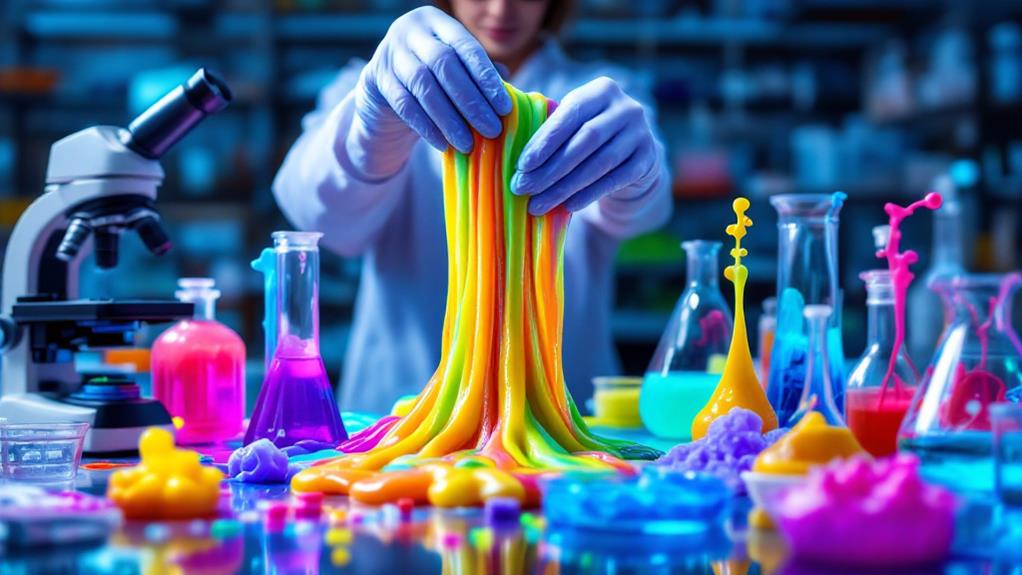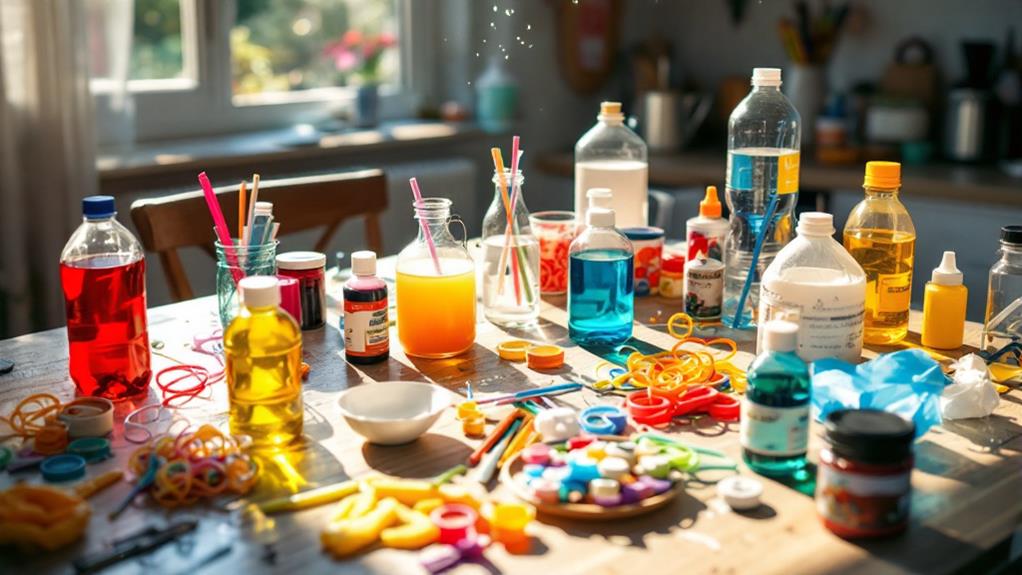Fun Facts About Polymer Slime: The Science Behind the Goo

Polymer slime is a fascinating non-Newtonian fluid that's both a solid and a liquid. It's made of long, chain-like molecules called polymers, typically from glue, that get cross-linked by borax. This unique structure gives slime its stretchy, gooey properties. When you apply force, the polymer chains align, making it feel solid, but it flows like a liquid when left alone. You can easily make slime at home with common ingredients, and scientists are even studying it for applications in medicine and environmental cleanup. There's more to this gooey substance than meets the eye, and you'll be amazed at what else it can do.
The Chemistry of Slime
Most slimes are fascinating examples of non-Newtonian fluids. When you make slime, you're creating a unique polymer that doesn't behave like typical liquids or solids. The chemistry behind slime involves a delicate balance of chemical interactions between its components.
At the heart of slime's structure are long, chain-like molecules called polymers. These polymers are usually made from polyvinyl alcohol (PVA) or polyvinyl acetate (PVAc). When you mix these polymers with a borax solution, something magical happens. The borax acts as a cross-linker, forming ionic bonds between the polymer chains. These bonds are strong enough to give slime its structure but weak enough to allow it to flow.
The result is a substance that can stretch, bounce, and ooze, depending on how you manipulate it. You can even alter slime's properties by changing the ratio of ingredients or adding other substances. For instance, adding more borax will make the slime firmer, while adding water will make it runnier. This flexibility in chemical composition is what makes slime so versatile and fun to experiment with.
Non-Newtonian Fluid Properties
Slime's unique chemical structure gives rise to its mesmerizing non-Newtonian fluid properties. Unlike Newtonian fluids like water, slime's viscosity changes depending on the force applied to it. This non-Newtonian behavior is what makes slime so fun to play with and manipulate.
When you're handling slime, you'll notice its viscosity variation in action. Here are some ways you can observe its non-Newtonian properties:
- Squeezing: The slime becomes firmer and more resistant
- Stretching: It flows and elongates easily
- Quick impacts: The slime acts more solid-like
- Slow movements: It behaves more fluid-like
These properties are due to the long polymer chains in slime. When you apply force, the chains temporarily align, increasing viscosity. When the force is removed, they return to their relaxed state. This is why slime can hold its shape for a moment before flowing back into a puddle.
Understanding slime's non-Newtonian behavior helps explain why it's so enchanting. It's not quite a solid, not quite a liquid, but something in between that responds uniquely to different types of stress and strain.
Polymers: The Backbone of Slime

At the heart of slime's fascinating properties lie polymers, long chains of repeating molecular units. These extraordinary structures give slime its unique texture and behavior. When you play with slime, you're actually manipulating countless polymer chains that stretch, bend, and intertwine.
The molecular structure of polymers in slime typically consists of long, flexible chains. These chains can slide past each other, allowing the slime to flow and stretch. However, they also have weak attractions between them, which give slime its cohesive nature. This balance between flexibility and cohesion is what makes slime so fun to play with.
Different types of polymers can be used to create slime, each imparting distinct characteristics. For example, polyvinyl alcohol (PVA) creates a more elastic slime, while polyacrylic acid results in a stickier consistency. By adjusting the types and concentrations of polymers, you can create slimes with various properties.
The polymer chains in slime also interact with other ingredients, such as borax or activators, to form temporary cross-links. These cross-links contribute to slime's ability to hold its shape while still being malleable. Understanding the role of polymers helps you appreciate the science behind this gooey wonder.
Cross-Linking and Slime Consistency
While polymers form the foundation of slime, it's the process of cross-linking that gives it its unique consistency. Cross-linking occurs when chemical bonds form between polymer chains, creating a network that affects the slime's properties. The degree of cross-linking determines how stretchy, bouncy, or fluid your slime will be.
The molecular weight and monomer arrangement of the polymers also play pivotal roles in slime consistency. Higher molecular weight polymers tend to create thicker, more elastic slimes, while lower molecular weight polymers result in more fluid slimes.
You can control the cross-linking process by adjusting the following factors:
- The type and amount of cross-linking agent used
- The pH of the mixture
- The temperature during the reaction
- The concentration of polymers in the solution
Borax: The Magic Ingredient

Borax, a common household cleaner, is the secret weapon in many slime recipes. This versatile compound, also known as sodium borate, acts as a cross-linking agent that connects PVA molecules in glue, creating the stretchy, slimy texture you love. When you mix borax with water and glue, it triggers a chemical reaction that enhances the liquid into a non-Newtonian fluid.
While borax's cleaning properties make it an effective laundry amplifier and all-purpose cleaner, it's this same ability to interact with other substances that makes it perfect for slime-making. However, it's important to be aware of borax safety concerns. Although it's generally considered safe for household use, ingestion or excessive skin exposure can cause irritation. When making slime, always supervise children and avoid direct contact with borax powder. Use gloves if necessary and wash your hands thoroughly after playing with the slime.
Despite these precautions, borax remains the go-to ingredient for creating the perfect slime consistency. Its unique properties allow you to adjust the slime's texture by varying the amount used, giving you control over your gooey creation.
DIY Slime Recipes
Slime enthusiasts rejoice! You can create your own squishy, stretchy slime right at home with a few simple ingredients. Before diving into the gooey fun, remember to follow slime safety guidelines, such as wearing gloves and avoiding ingestion. Now, let's explore some popular DIY slime recipes:
- Basic Slime: Mix white glue, water, and borax solution
- Fluffy Slime: Combine shaving cream with glue and activator
- Magnetic Slime: Add iron oxide powder to your basic slime recipe
- Glow-in-the-Dark Slime: Incorporate phosphorescent pigments
Experiment with different colors, textures, and add-ins like glitter or foam beads to customize your creations. As you perfect your slime-making skills, don't forget about proper storage techniques for homemade slime. Keep it in an airtight container to prevent drying out, and store it away from direct sunlight and heat sources. With these tips and recipes, you'll be well on your way to becoming a skilled slime maker. Remember, the key to successful slime-making is finding the right balance of ingredients and having fun with the process!
Slime in Scientific Research

Beyond its popularity as a toy, polymer slime has captured the attention of scientists across various fields. You'll find researchers using slime-like materials in numerous scientific applications, from examining fluid dynamics to developing new materials with unique properties.
In biomedical research, slime-inspired hydrogels are being investigated for drug delivery systems and tissue engineering. These materials can mimic the properties of human tissues, making them meaningful for creating artificial organs or testing new medications. Scientists are also examining slime's self-healing properties, which could lead to innovative wound dressings or self-repairing materials.
Environmental scientists are using slime-like substances to clean up oil spills and remove pollutants from water. The sticky, absorbent nature of these materials makes them effective at trapping contaminants. In robotics, researchers are developing soft, flexible robots inspired by slime molds, capable of traversing complex environments.
You might be surprised to learn that studying slime has even contributed to our understanding of non-Newtonian fluids, which behave differently under stress. This knowledge has applications in industries ranging from food processing to automotive manufacturing, showcasing how a simple toy can lead to significant scientific breakthroughs.
Environmental Impact of Slime
While polymer slime brings joy to many, its environmental impact can't be ignored. As you create and play with slime, it's important to examine how it affects our planet. Most commercial slimes contain non-biodegradable materials, which can harm ecosystems if not disposed of properly.
However, you can make more eco-friendly slime choices. Opt for slimes made with sustainable ingredients or create your own using recycled materials. Here are some ways to minimize the environmental impact of your slime hobby:
- Choose slimes with natural, biodegradable ingredients
- Make your own slime using household items
- Properly dispose of slime in the trash, not down drains
- Reuse slime containers for storage or crafts



